- Ruth Hesse
- Sergei Vasilyevich Rakhmaninov
- Associazione Operapocket
- William Sterndale Bennett
- Crucifixion
- J S Bach: The Well Tempered Clavier
- Copland: Appalachian Spring
- Kat Farn
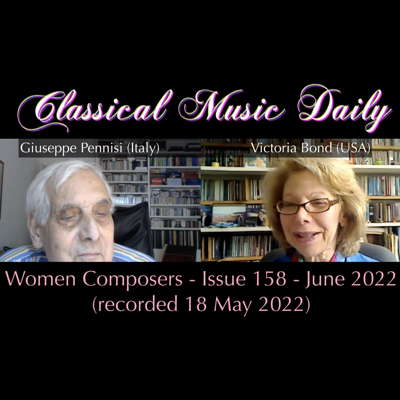 VIDEO PODCAST: Women Composers - Our special hour-long illustrated feature on women composers includes contributions from Diana Ambache, Gail Wein, Hilary Tann, Natalie Artemas-Polak and Victoria Bond.
VIDEO PODCAST: Women Composers - Our special hour-long illustrated feature on women composers includes contributions from Diana Ambache, Gail Wein, Hilary Tann, Natalie Artemas-Polak and Victoria Bond.
 DISCUSSION: What is a work? John Dante Prevedini leads a discussion about The performing artist as co-creator, including contributions from Halida Dinova, Yekaterina Lebedeva, Béla Hartmann, David Arditti and Stephen Francis Vasta.
DISCUSSION: What is a work? John Dante Prevedini leads a discussion about The performing artist as co-creator, including contributions from Halida Dinova, Yekaterina Lebedeva, Béla Hartmann, David Arditti and Stephen Francis Vasta.
A Miracle in Ravenna
GIUSEPPE PENNISI reports from
a modified Ravenna Festival
For the last thirty one years, Ravenna has had a major festival in the Summer and for the last eighteen years a shorter but dense festival in the Fall, in addition, of course, to the regular opera and concert seasons. For Summer 2020, it was announced a major interdisciplinary initiative almost as vast and as complex as that of Salzburg: ten different venues (including a modern concert hall for an audience of about three thousand and a nineteenth century opera house for some nine hundred) and a calendar with some 150 performances of concerts, ballets and plays. The program was suspended due to the coronavirus. Like Salzburg, Ravenna did not cancel it but awaited for the situation to evolve.
In mid-May, a new program was put forward to the authorities. The authorization was enacted almost in June. On 21 June, Riccardo Muti was in the pit conducting the Cherubini Orchestra in a Mozart concert. A real miracle. The entire town made efforts to help the revised program to be implemented.
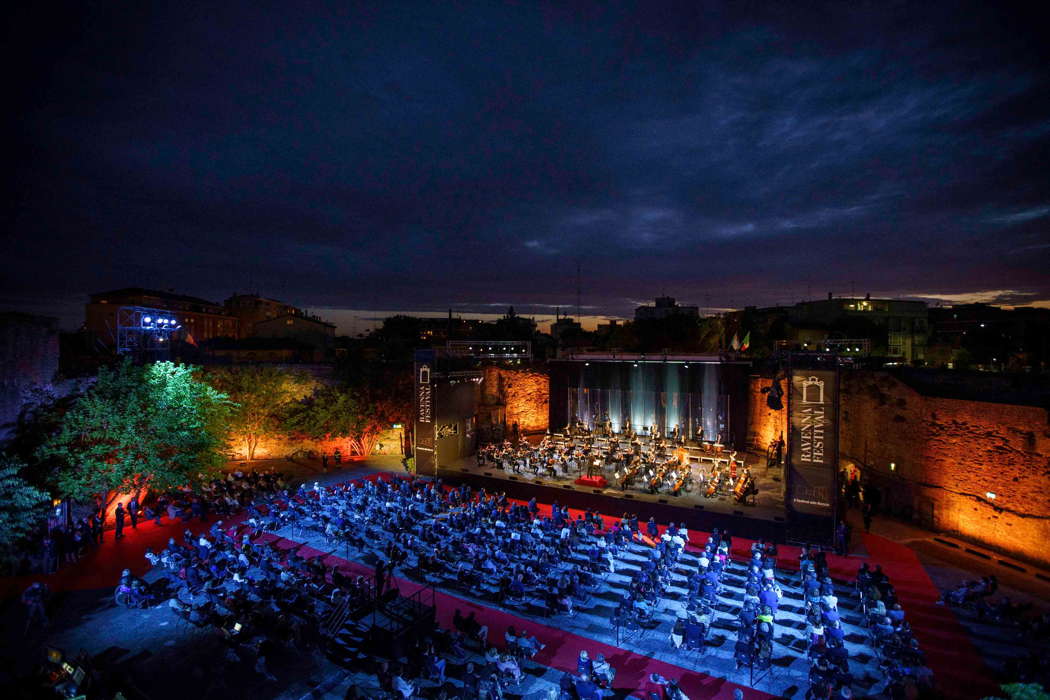
Riccardo Muti conducting the Cherubini Orchestra on 21 June. Photo © 2020 Silvia Lelli
The new program entails forty events, almost all of them in the Rocca Brancaleone, a fortress built by the Venetians in the fifteenth century, when the Republic was controlling the Adriatic coastlines and sea. The main courtyard could host an audience of a thousand, but for the festival, only three hundred seats are available in order to maintain social distancing. The concerts last about a hour and a half without intermissions. Tickets and programs are paperless and mailed to the smartphones of audience members. Sanitation rules are applied very strictly.
It was very hard to get tickets to the inaugural concerts, also because of the large number of local authorities and enterprises supporting the festival. However, the concert was offered in streaming and enjoying by a million listeners and viewers (including your reviewer), mostly from Germany, Japan and the United States, in this order. The performance of the Cherubini Orchestra under Muti's baton was superb; they rendered a very Italian Mozart, with delicate phrasing, contrasting sentiments and colours as well as ambiguity. A tremendous success.
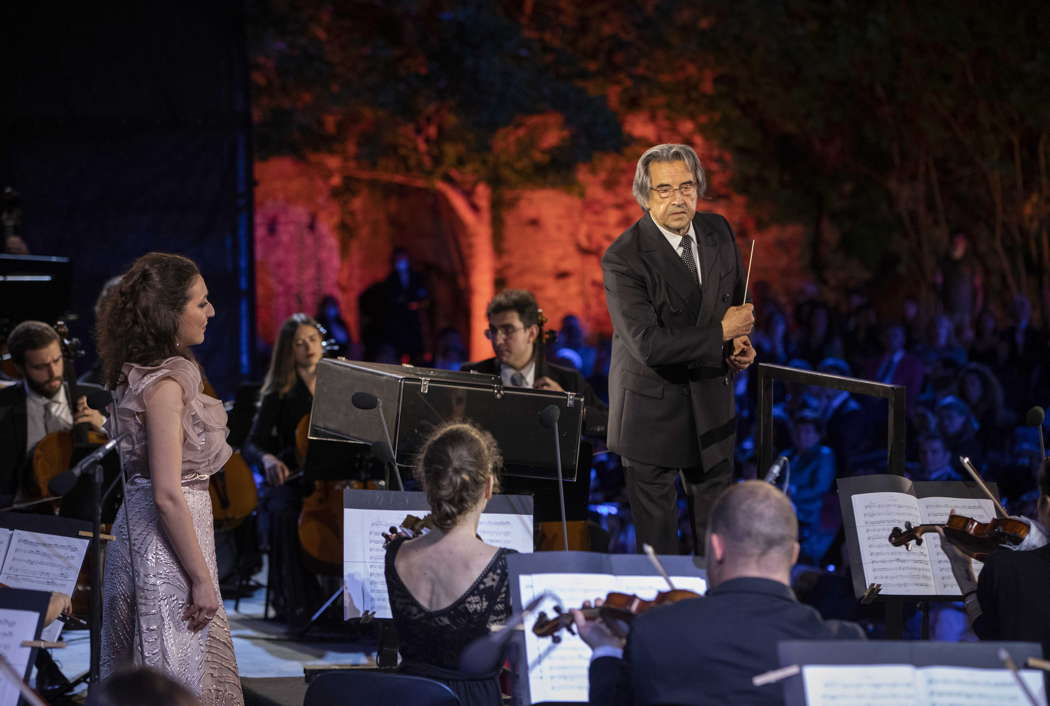
Riccardo Muti conducting the Cherubini Orchestra on 21 June. Photo © 2020 Silvia Lelli
I attended the 24 and 25 June concerts that dealt with baroque music and an homage to Beethoven.
On 24 June, the program featured Il Trionfo del Tempo e del Disinganno (The Triumph of Time and Disillusion). This is a Lenten oratorio commissioned of the young Handel by Cardinal Benedict Pamphilj, a refined aesthete, on the theme of the fleetingness of physical beauty and youth. There are only four characters/singers and an orchestra of eighteen instrumentalists (including the concertmaster at the harpsichord). It had its debut at the Rome Pamphilj Palace in May 1707 – it is not known whether it was presented in concert form or in a staged form – probably as a part of a musical evening in which a banquet was also served. Modified, expanded and with rhythmic translation in English, it was revived at Covent Garden in 1737 and 1757 - Handel, therefore, worked on this work throughout his life, aware of the richness and innovation of his youthful score. Over the years, many musical numbers were 'borrowed' and embedded in other works, for example Rinaldo.
The oratorio was revived in modern times both in concert form - I remember a beautiful performance at the Church of Saints Apostles in 2009 by the Roma Baroque complex directed by Lorenzo Tozzi - and in scenic form, at the Malatestiana Festival in 2007 and at La Scala in 2016. The La Scala production was reviewed in Music & Vision on 9 February 2016.
The fully staged versions have a dramaturgy that emphasizes sensual and sometimes erotic aspects of the score (and of some points of the libretto), not the moralistic, almost Lutheran or Calvinist character of the work. Prince Pamphilj was culturally the son of the counter-reformation and the young Handel an exponent of Protestant culture. In my opinion, this aspect is not secondary. It can be fully appreciated in the concert version presented at the Ravenna festival, despite the fact that, in order to comply with the health rules, the work is abridged in the recitatives and arias.
Conductor Ottavio Dantone (at the harpsichord) and the eighteen soloists of the Accademia Bizantina - a group resident in Ravenna - offered a clear reading in which the Baroque blooms are maintained as strictly as necessary. A reading, therefore, dramatic and moralistic (as in a parable) but not sensual. This was a compelling reading, however, greeted with applause from the audience.
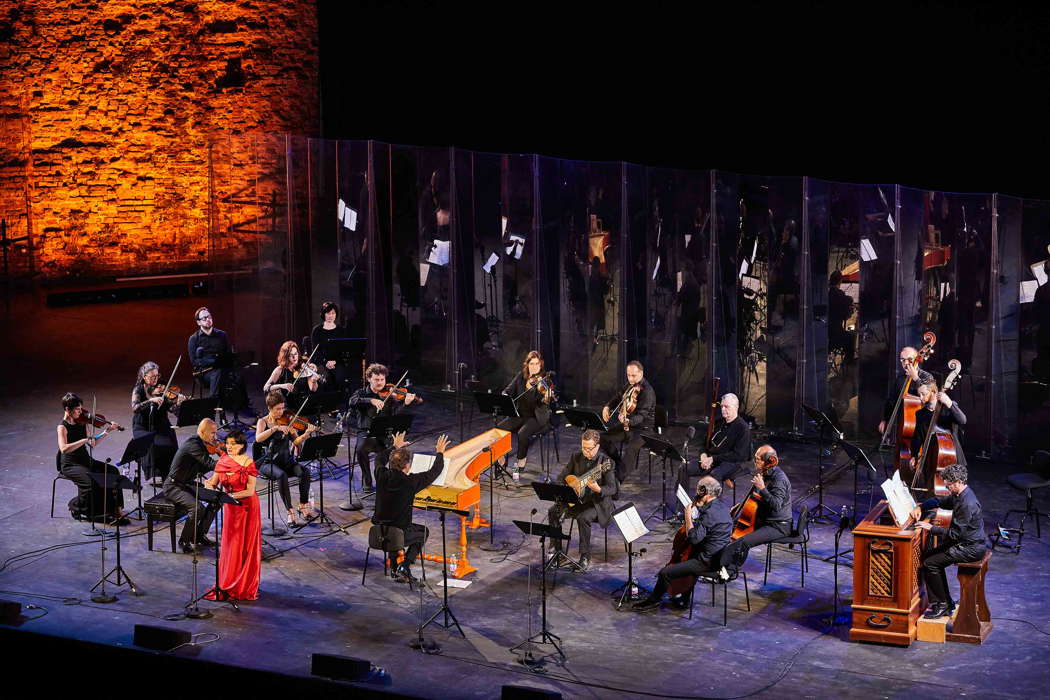
Handel's Il Trionfo del Tempo e del Disinganno in Ravenna on 24 June. Photo © 2020 Zani Casadio
Amongst the young cast was Emmanuelle de Neri, an established soprano, in the role of Pleasure, with arias of great difficulties such as the extreme attempt to induce Beauty (Monica Piccinini) to sin: Lascia la spina. Even in a shortened version, Monica Piccinini, a light lyrical soprano, has many numbers (and especially arias in which she has to show off coloratura). She uses the emission with sagacity to avoid arriving tired at the long and difficult final aria Tu del Ciel. Delphine Galou (Disillusion) is a alto known for performing baroque music. Especially important are the two duets with the tenor. Alongside the women's voices (in which there is no shortage, as has been said - of coloratura), in the role of The Time, Anicio Zorzi Giustiniani dominates the center register with tempered and very well groomed phrasing.
For the Beethoven celebrations, the Festival, not being able to use venues this year to host great symphonies, proposed an original and innovative program on 25 June: a piano recital of transcriptions and studies inspired by or based on works of the great master of Bonn. It entrusted the concert to twenty-eight-year-old Nikolay Khozyainov, a new star in the international piano firmament. Khozyainov was an enfant prodige, skilled on the keyboard as early as five years old. He has collected numerous international awards in Europe, North America and Australia. He is currently in residence at the Hochschule für Musik in Hanover. He has some CDs to his credit.
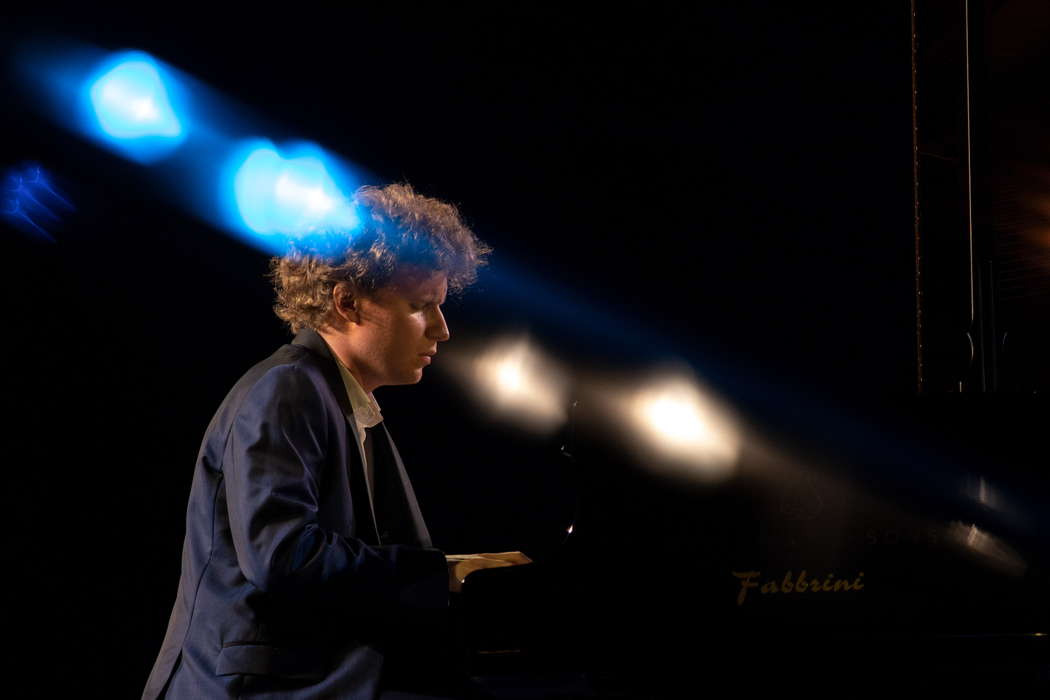
Nikolay Khozyainov's Ravenna recital on 25 June. Photo © 2020 Luca Concas
The recital included the transcriptions of the second movement, Allegretto, from the Seventh Symphony, of the Lied 'Nimm sie hin denn, diese Lieder' from An die ferne Geliebte Op 98 by Franz Liszt. It included also the studies in the form of variations on a theme of Beethoven WoO 31 and the Fantasy in C major, Op 17 by Robert Schumann; the Prelude in C sharp minor Op 45 by Fryderyk Chopin as well as Variations sérieuses Op 54 by Felix Mendelssohn-Bartholdy. So, Beethoven, the great classicist but with a Romantic spirit, as read by great Romantic composers. Khozyainov tackled it by interpreting the scores from memory, with great intensity and even virtuosity.
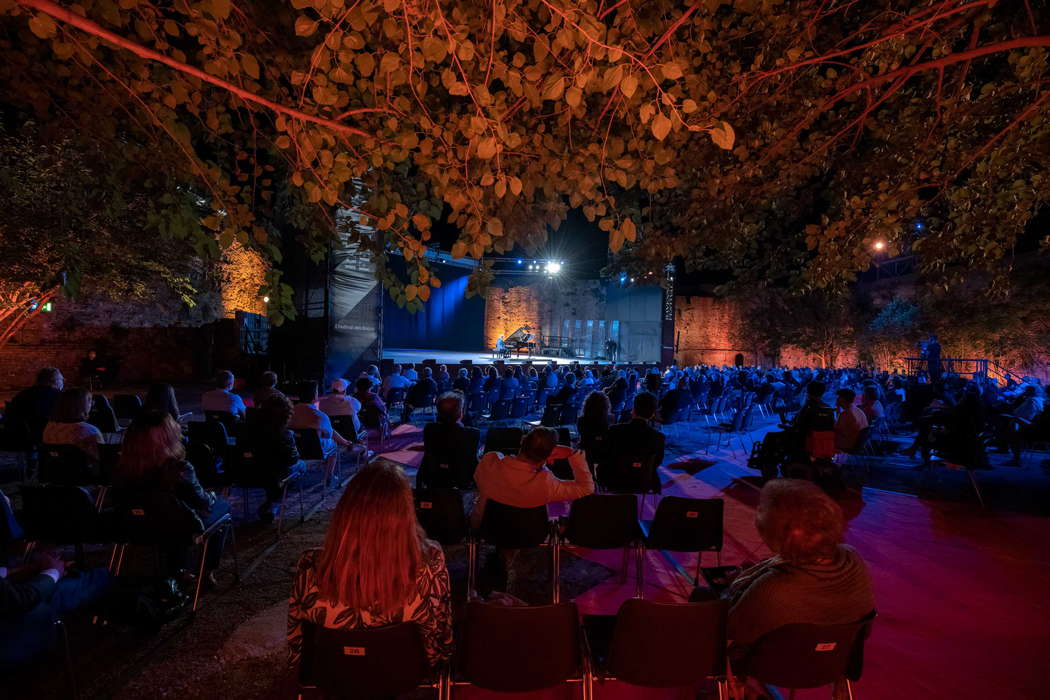
Nikolay Khozyainov's Ravenna recital on 25 June. Photo © 2020 Luca Concas
The audience got excited and asked for encores. Khozyainov granted four: transcriptions of the fourth movement of the Ninth Symphony, of the fourth act of Verdi's Rigoletto, of the second act of Puccini's Madama Butterly and of the popular song O' Sole Mio.
Copyright © 28 June 2020
Giuseppe Pennisi,
Rome, Italy

FURTHER LIVE CONCERT AND OPERA REVIEWS


